

A lug nut or wheel nut is a fastener, specifically a nut, used to secure a wheel on a vehicle. Typically, lug nuts are found on automobiles, trucks (lorries), and other large vehicles using rubber tires.


A lug nut or wheel nut is a fastener, specifically a nut, used to secure a wheel on a vehicle. Typically, lug nuts are found on automobiles, trucks (lorries), and other large vehicles using rubber tires.
A lug nut is a nut fastener with one rounded or conical (tapered) end, used on steel and most aluminum wheels. A set of lug nuts is typically used to secure a wheel to threaded wheel studs and thereby to a vehicle's axles. Some designs (Audi, BMW, Mercedes-Benz, Saab, Volkswagen) use lug bolts or wheel bolts instead of nuts, which screw into a tapped (threaded) hole in the wheel's hub or brake drum or brake disc.
The conical lug's taper is normally 60 degrees (although 45 degrees is common for wheels designed for racing applications), and is designed to help center the wheel accurately on the axle, and to reduce the tendency for the nut to loosen due to fretting induced precession, as the car is driven. One popular alternative to the conical lug seating design is the rounded, hemispherical, or ball seat. Automotive manufacturers such as Audi, BMW, and Honda use this design rather than a tapered seat, but the nut performs the same function.[ dubious ][ citation needed ] Older style (non-ferrous) alloy wheels use nuts with a 13 to 25 mm (1⁄2 to 1 in) cylindrical shank slipping into the wheel to center it and a washer that applies pressure to clamp the wheel to the axle.
Wheel lug nuts may have different shapes. Aftermarket alloy and forged wheels often require specific lug nuts to match their mounting holes, so it is often necessary to get a new set of lug nuts when the wheels are changed.
There are four common lug nut types:
The lug nut thread type varies between car brands and models. Examples of commonly used metric threads include: [1] [2]
Some older American cars use inch threads, for example 7⁄16″-20 (11.1 mm), 1⁄2″-20 (12.7 mm), or 9⁄16″-20 (14.3 mm). [2]

Lug nuts may be removed using a lug, socket, or impact wrench. If the wheel is to be removed, an automotive jack to raise the vehicle and some wheel chocks would be used as well. Wheels that have hubcaps or wheel covers need these removed beforehand, typically with a screwdriver, [4] flatbar, or prybar. Lug nuts can be difficult to remove, as they may become frozen to the wheel stud. In such cases a breaker bar or repeated blows from an impact wrench can be used to free them. Alternating between tightening and loosening can free especially stubborn lug nuts.
Lug nuts must be installed in an alternating pattern, commonly referred to as a star pattern. [5] This ensures a uniform distribution of load across the wheel mounting surface. When installing lug nuts, it is recommended to tighten them with a calibrated torque wrench. While a lug, socket, or impact wrench may be used to tighten lug nuts, the final tightening should be performed by a torque wrench, ensuring an accurate and adequate load is applied. Torque specifications vary by vehicle and wheel type. Both vehicle and wheel manufacturers provide recommended torque values which should be consulted when an installation is done. Failure to abide by the recommended torque value can result in damage to the wheel and brake rotor/drum. Additionally, under-tightened lug nuts may come loose with time.
The tool size needed for removal and installation depends on the type of lug nut. The three most common hex sizes for lug nuts are 17 mm, 19 mm, and 21 mm, while 22 mm, 23 mm, 11⁄16 inch (17.5 mm), and 13⁄16 inch (20.6 mm) are less commonly used.
In order to allow early detection of loose lug nuts, some large vehicles are fitted with loose wheel nut indicators. The indicator spins with the nut so that loosening can be detected with a visual inspection.
In countries where the theft of alloy wheels is a serious problem, locking nuts (or bolts, as applicable) are available - or already fitted by the vehicle manufacturer - which require a special adaptor ("key") between the nut and the wrench to fit and remove. The key is normally unique to each set of nuts. Only one locking nut per wheel is normally used, so they are sold in sets of four. Most designs can be defeated using a hardened removal tool which uses a left-hand self-cutting thread to grip the locking nut, although more advanced designs have a spinning outer ring to frustrate such techniques. An older technique for removal was to simply hammer a slightly smaller socket over the locking wheel nut to be able to remove it. However, with the newer design of locking wheel nuts this is no longer possible. Removal nowadays requires special equipment that is not available to the general public. This helps to prevent thieves from obtaining the tools to be able to remove the lock nuts themselves.[ dubious ]
In the United States, vehicles manufactured prior to 1975 by the Chrysler Corporation used left-hand and right-hand screw thread for different sides of the vehicle to prevent loosening. Most Buicks, Pontiacs, and Oldsmobiles used both left-handed and right-handed lug nuts prior to model year 1965. [6] It was later realized that the taper seat performed the same function. Most modern vehicles use right-hand threads on all wheels.
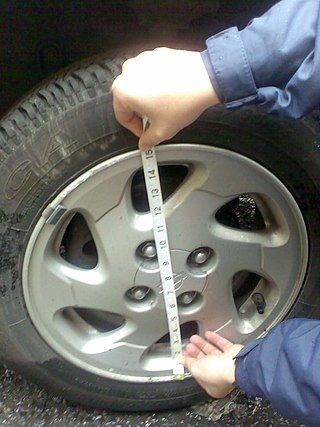
The wheel size for a motor vehicle or similar wheel has a number of parameters.

A bolted joint is one of the most common elements in construction and machine design. It consists of a male threaded fastener that captures and joins other parts, secured with a matching female screw thread. There are two main types of bolted joint designs: tension joints and shear joints.

A socket wrench is a type of spanner that uses a closed socket format, rather than a typical open wrench/spanner to turn a fastener, typically in the form of a nut or bolt.
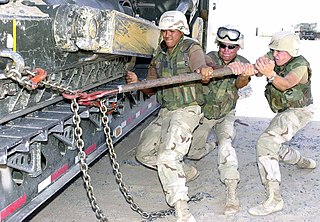
A cheater bar, snipe, or cheater pipe is an improvised breaker bar made from a length of pipe and a wrench (spanner).

A lug wrench, also colloquially known as a tire iron, is the name for a type of socket wrench used to loosen and tighten lug nuts on automobile wheels. In the United Kingdom and Australia, it is commonly known as a wheel brace.
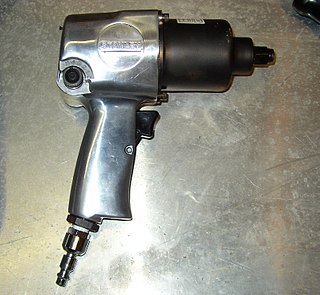
An impact wrench is a socket wrench power tool designed to deliver high torque output with minimal exertion by the user, by storing energy in a rotating mass, then delivering it suddenly to the output shaft. It was invented by Robert H. Pott of Evansville, Indiana.

A peanut butter wrench, also known as a crank bolt spanner or a crank spanner, is a single-ended box wrench or ring spanner used in cycling to tighten older 14 mm and 15 mm crank bolts, or the wheel nuts on hubs with solid axles commonly found on track bicycles, particularly the 15 mm wrench made by Campagnolo. This is the only one-piece wrench that can be used to tighten or loosen the bolt or nut which holds the crank to a square-taper bottom bracket spindle, whereas any wrench/spanner of the correct size will tighten or loosen wheel nuts.

Wheel studs are the threaded fasteners that hold on the wheels of many automobiles. They are semi-permanently mounted directly to the vehicle hub, usually through the brake drum or brake disk. Lug nuts are fastened onto the wheel stud to secure the wheel. When a wheel is removed for tire changes etc., the stud remains in the hub.

A loose wheel nut indicator is a measuring tool that warns of loose wheel nuts, which is the most common cause of wheels on vehicles falling off.
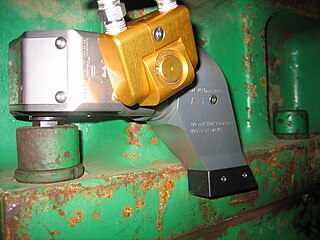
A hydraulic torque wrench is a power tool designed to exert torque on a fastener to achieve proper tightening or loosening of a connection through the use of hydraulics. A torque wrench is applied to the nut either directly or in conjunction with an impact socket. Hydraulic torque wrenches apply a predetermined, controlled amount of torque to a properly lubricated fastener.
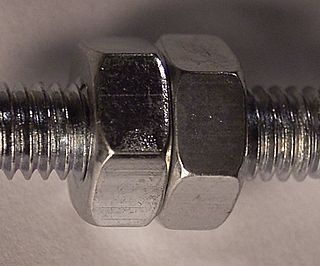
A jam nut is a low profile type of nut, typically half as tall as a standard nut. It is commonly used as a type of locknut, where it is "jammed" up against a standard nut to lock the two in place. It is also used in situations where a standard nut would not fit.
Multi-jackbolt tensioners (MJT) are an alternative to traditional bolted joints. Rather than needing to tighten one large bolt, MJTs use several smaller jackbolts to significantly reduce the torque required to attain a certain preload. MJTs range in thread sizes from 3⁄4 in (19 mm) to 32 in (810 mm) and can achieve 20 million pounds-force or more. MJTs only require hand-held tools, such as torque wrenches or air/electric impacts, for loading and unloading bolted joints.

A screw and a bolt are similar types of fastener typically made of metal and characterized by a helical ridge, called a male thread.

A nut is a type of fastener with a threaded hole. Nuts are almost always used in conjunction with a mating bolt to fasten multiple parts together. The two partners are kept together by a combination of their threads' friction, a slight stretching of the bolt, and compression of the parts to be held together.
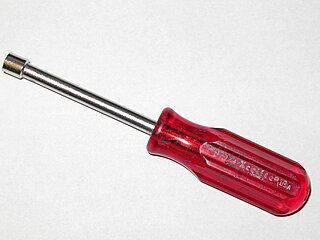
A nut driver is a tool for tightening or loosening nuts and bolts. It essentially consists of a socket attached to a shaft and cylindrical handle and is similar in appearance and use to a screwdriver. They generally have a hollow shaft to accommodate a shank onto which a nut is threaded. They are typically used for lower torque applications than wrenches or ratchets and are frequently used in the appliance repair and electronics industries.

Two-dimensional rotation can occur in two possible directions. Clockwise motion proceeds in the same direction as a clock's hands: from the top to the right, then down and then to the left, and back up to the top. The opposite sense of rotation or revolution is anticlockwise (ACW) or counterclockwise (CCW).

A bolt is a form of threaded fastener with an external male thread requiring a matching pre-formed female thread such as a nut. Bolts are very closely related to screws.

Width across flats is the distance between two parallel surfaces on the head of a screw or bolt, or a nut, mostly for torque transmission by positive locking.
A centerlock wheel is a type of automobile wheel in which the wheel is fastened to the axle using a single, central nut, instead of the more common ring of 4 or 5 lug nuts or bolts.